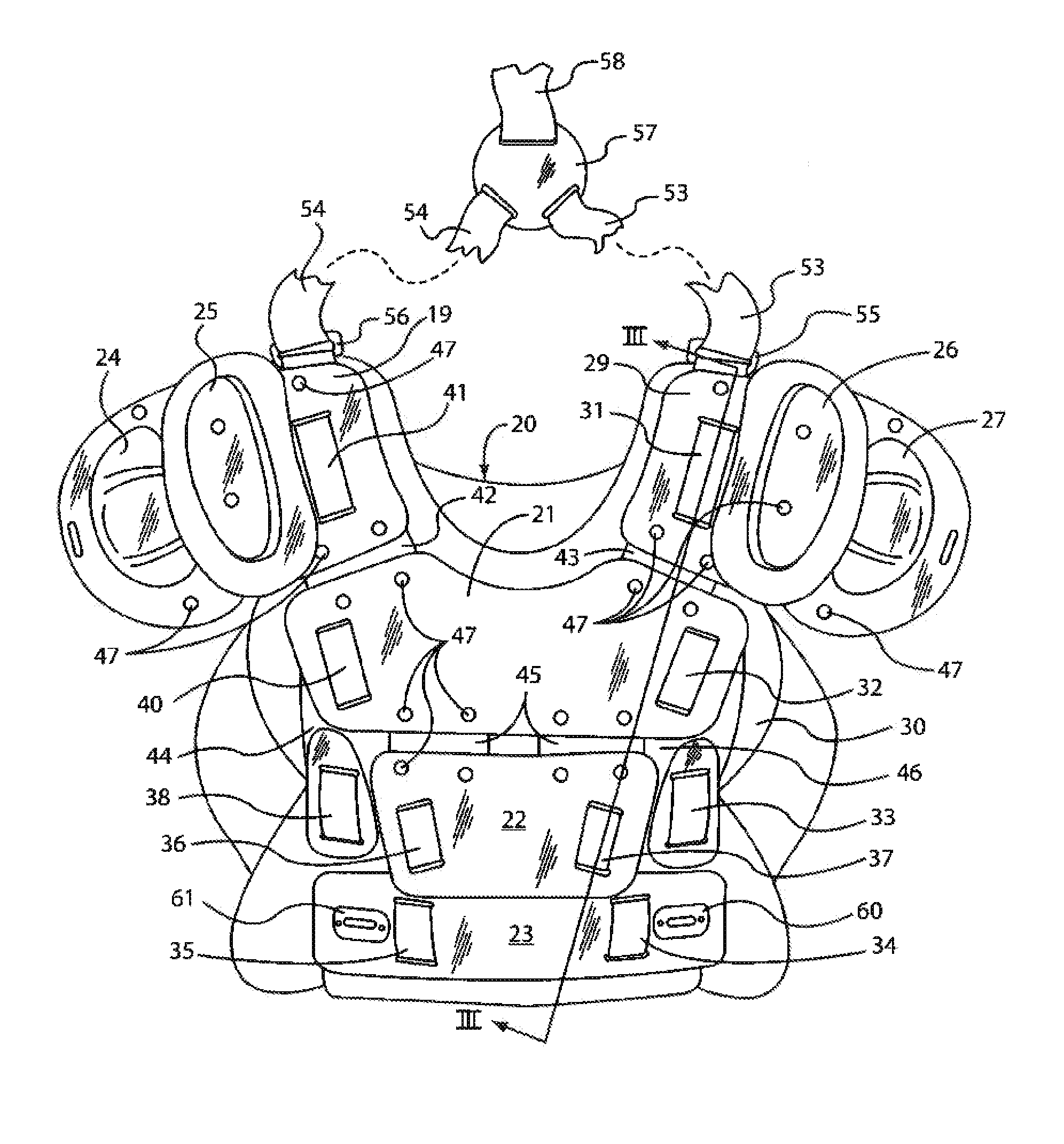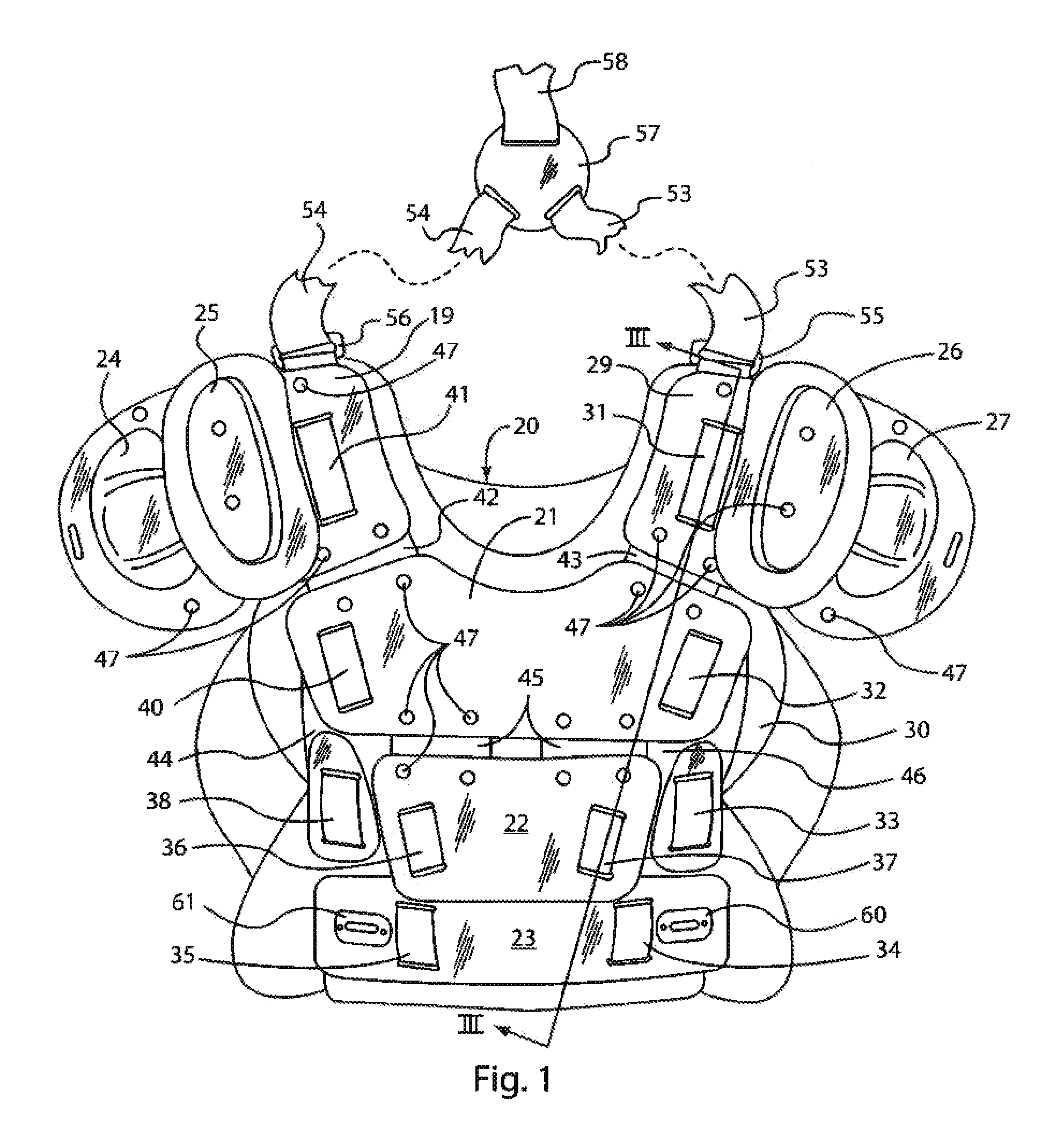Many inadequate approaches are and have been used to produce conventional protective equipment, resulting in products that provide minimal protection against force impacts and typically provide no capacity to modify the wearer's
microclimate.
Moreover, most ‘temperature controlled’ sports garments, such as the Nike® pre-cool Olympic garment, are bulky and heavy, cannot be produced to, target a given desired temperature or range of temperatures, are often restrictive of wearer movement, and provide little or no protection against and may even degrade protection from force impacts.
U.S. Pat. No. 5,530,966, the complete disclosure of which is herein incorporated by reference, discloses several sports
protective garment embodiments that differentiate against then previously known art for protecting the wearer from force impact, but it does not disclose techniques for controlling
microclimate.
However, these deformations and vibrations cannot occur instantaneously.
A high-velocity collision (an impact) does not provide
sufficient time for these deformations and vibrations to occur.
Thus, the struck material behaves as if it were more brittle than it is, and the majority of the applied force goes into fracturing the material.
Ductile materials like steel tend to become more brittle at
high loading rates, and spalling may occur on the reverse side to the impact if penetration doesn't occur.
Since most materials are weaker in tension than compression, this is the zone where cracks tend to form and grow.
To the extent that the outer shell or layer is unable to deflect a blow in the area of the impact, the energy will be transferred to the underlying material in a more localized manner, resulting in a high force per unit of area that is likely to cause greater injury than if the force were more distributed.
This said, it should be recognized that materials capable of providing impact protection at certain speeds generally provide inadequate protection at other speeds.
For example, rigid or non-resilient materials may be effective at protecting the wearer at high impact speeds but are almost wholly ineffective at absorbing the
impact energy of
low speed impacts.
None of this, however, considers the integration of effective microclimate control into the sports
protective garment.
Heretofore, it has not been possible to integrate both state of the art force impact protection and state of the art microclimate control in a light garment that still affords necessary flexibility and
range of motion.
Unfortunately, previous efforts to create garments that modify wearer microclimate suffer from profound disadvantages when used in sporting applications, including: adding too much weight to the wearer (which detracts from physical achievement or results), overly restricting the wearer's
range of motion, requiring proximal connection to ancillary systems—to enable recirculation, for instance and creating a sub-optimal microclimate temperature and thermal consistency when viewed from the perspective of either ambient temperature or what is considered safe for long-term use in close proximity to the body.
It is well documented, for instance, that overly cold temperatures, such as can be created by ice or gels, cause
vasoconstriction and reduced capillary flow—which ultimately overcomes the body's own internal cooling systems and can lead to dangerous overheating.
Beyond these significant thermal challenges, heretofore, the incorporation of available cooling or warming systems into sports protective garments has degraded the garment's force impact capabilities.
Liquid-
gas phase changes are not practical for use as thermal storage due to the large volumes or high pressures required to store the materials when in their
gas phase.
Solid-
solid phase changes are typically very slow and have a rather low heat of transformation.
Certain
properties of water / ice, however, may render it of little use (or useless) in given applications, including: the phase temperature cannot be modified (ice is too cold for extended use in most biological cooling applications, for instance, as applying ice to tissue quickly results in
vasoconstriction and vastly reduced capillary
blood flow—often resulting in
skin or
tissue damage), the water to ice transition results in a volumetric expansion of ˜9%—making it a challenge to use in mechanical applications, and ice exhibits little mechanical “give” in the fully frozen state.
While this expansion isn't particularly relevant in most sports protective garment applications, the overly cold temperature is.
Others lose the capacity to transition sharply after a certain number of uses (eutectics often degrade after a few thousand cycles, rendering them of little use in most applications).
Because some are caustic they have to be encapsulated in
inert materials, reducing their
effective energy storage capacity for a given volume of PCM.
 Login to View More
Login to View More  Login to View More
Login to View More 


